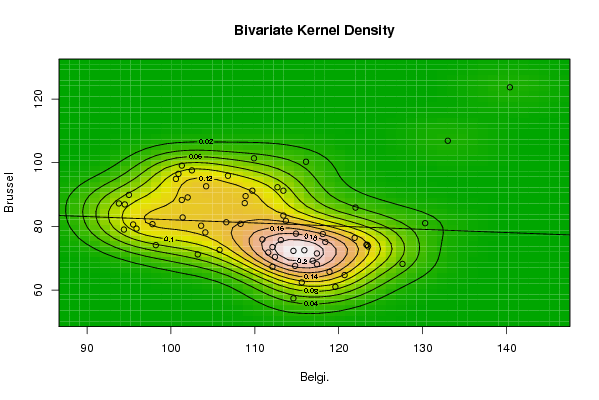Free Statistics
of Irreproducible Research!
Description of Statistical Computation | |||||||||||||||||||||||||||||||||||||||||||||
|---|---|---|---|---|---|---|---|---|---|---|---|---|---|---|---|---|---|---|---|---|---|---|---|---|---|---|---|---|---|---|---|---|---|---|---|---|---|---|---|---|---|---|---|---|---|
| Author's title | |||||||||||||||||||||||||||||||||||||||||||||
| Author | *The author of this computation has been verified* | ||||||||||||||||||||||||||||||||||||||||||||
| R Software Module | rwasp_bidensity.wasp | ||||||||||||||||||||||||||||||||||||||||||||
| Title produced by software | Bivariate Kernel Density Estimation | ||||||||||||||||||||||||||||||||||||||||||||
| Date of computation | Sat, 08 Nov 2008 05:21:31 -0700 | ||||||||||||||||||||||||||||||||||||||||||||
| Cite this page as follows | Statistical Computations at FreeStatistics.org, Office for Research Development and Education, URL https://freestatistics.org/blog/index.php?v=date/2008/Nov/08/t1226146960uk1a76mvyo81eu7.htm/, Retrieved Sat, 12 Jul 2025 05:35:33 +0000 | ||||||||||||||||||||||||||||||||||||||||||||
| Statistical Computations at FreeStatistics.org, Office for Research Development and Education, URL https://freestatistics.org/blog/index.php?pk=22583, Retrieved Sat, 12 Jul 2025 05:35:33 +0000 | |||||||||||||||||||||||||||||||||||||||||||||
| QR Codes: | |||||||||||||||||||||||||||||||||||||||||||||
|
| |||||||||||||||||||||||||||||||||||||||||||||
| Original text written by user: | |||||||||||||||||||||||||||||||||||||||||||||
| IsPrivate? | No (this computation is public) | ||||||||||||||||||||||||||||||||||||||||||||
| User-defined keywords | |||||||||||||||||||||||||||||||||||||||||||||
| Estimated Impact | 290 | ||||||||||||||||||||||||||||||||||||||||||||
Tree of Dependent Computations | |||||||||||||||||||||||||||||||||||||||||||||
| Family? (F = Feedback message, R = changed R code, M = changed R Module, P = changed Parameters, D = changed Data) | |||||||||||||||||||||||||||||||||||||||||||||
| F [Bivariate Kernel Density Estimation] [Bivariate Density] [2008-11-08 12:21:31] [00a0a665d7a07edd2e460056b0c0c354] [Current] F [Bivariate Kernel Density Estimation] [bivariate density] [2008-11-09 16:00:29] [8d78428855b119373cac369316c08983] | |||||||||||||||||||||||||||||||||||||||||||||
| Feedback Forum | |||||||||||||||||||||||||||||||||||||||||||||
Post a new message | |||||||||||||||||||||||||||||||||||||||||||||
Dataset | |||||||||||||||||||||||||||||||||||||||||||||
| Dataseries X: | |||||||||||||||||||||||||||||||||||||||||||||
116,1 102,5 102,0 101,3 100,6 100,9 104,2 108,3 108,9 109,9 106,8 112,7 113,4 101,3 97,8 95,0 93,8 94,5 101,4 105,8 106,6 109,7 108,8 113,4 113,7 103,6 98,2 95,5 94,4 95,9 103,2 104,1 127,6 130,3 133,0 140,4 123,5 116,9 115,9 113,1 112,1 112,4 118,9 117,4 115,6 120,7 114,9 122,0 119,6 114,6 118,4 110,9 111,6 114,6 112,1 117,4 114,8 123,4 118,1 121,9 123,3 | |||||||||||||||||||||||||||||||||||||||||||||
| Dataseries Y: | |||||||||||||||||||||||||||||||||||||||||||||
100,3 97,6 89,1 99,1 94,9 96,5 92,6 80,8 89,5 101,4 95,9 92,3 91,2 88,3 80,7 89,9 87,2 86,9 82,8 72,6 81,3 91,2 87,3 83,4 81,7 80,2 74,1 80,6 79,0 79,3 71,2 78,1 68,2 81,0 106,9 123,7 73,7 69,2 72,5 75,7 73,5 70,4 65,7 68,1 62,4 64,7 77,7 85,9 61,0 57,4 75,1 75,9 71,8 72,3 67,3 71,5 67,6 74,2 77,6 76,4 74,2 | |||||||||||||||||||||||||||||||||||||||||||||
Tables (Output of Computation) | |||||||||||||||||||||||||||||||||||||||||||||
| |||||||||||||||||||||||||||||||||||||||||||||
Figures (Output of Computation) | |||||||||||||||||||||||||||||||||||||||||||||
Input Parameters & R Code | |||||||||||||||||||||||||||||||||||||||||||||
| Parameters (Session): | |||||||||||||||||||||||||||||||||||||||||||||
| par1 = 50 ; par2 = 50 ; par3 = 0 ; par4 = 0 ; par5 = 0 ; par6 = Y ; par7 = Y ; | |||||||||||||||||||||||||||||||||||||||||||||
| Parameters (R input): | |||||||||||||||||||||||||||||||||||||||||||||
| par1 = 50 ; par2 = 50 ; par3 = 0 ; par4 = 0 ; par5 = 0 ; par6 = Y ; par7 = Y ; | |||||||||||||||||||||||||||||||||||||||||||||
| R code (references can be found in the software module): | |||||||||||||||||||||||||||||||||||||||||||||
par1 <- as(par1,'numeric') | |||||||||||||||||||||||||||||||||||||||||||||





